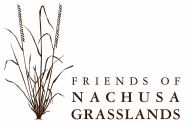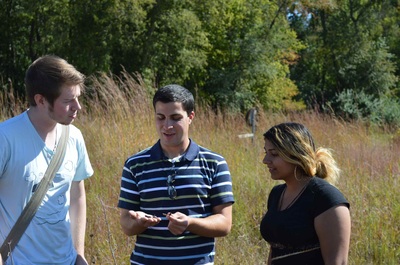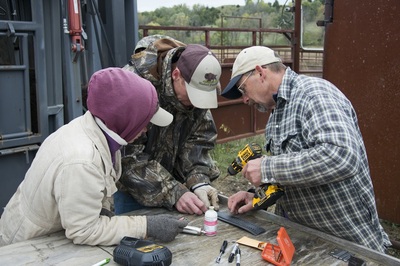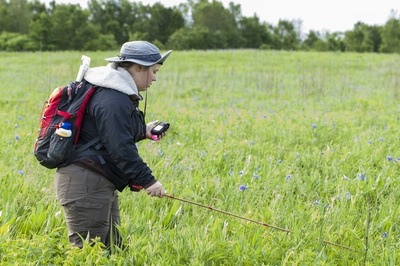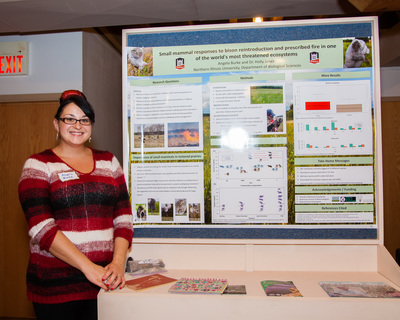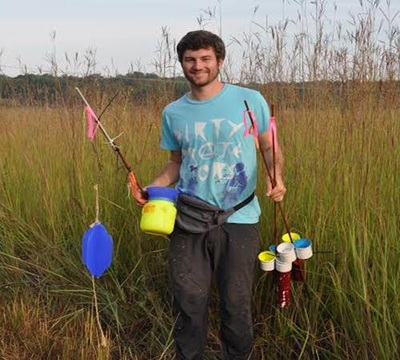2016 Friends of Nachusa Grasslands Scientific Research Grant Awards and
Project Summaries — $20,000
|
Laura Adamovicz, DVM, PhD graduate student, University of Illinois at Urbana-Champaign. Ornate Box Turtle (Terrapene ornata) Health Assessments at the Nachusa Grasslands — Dr. Adamovicz is going to conduct complete veterinary physical exams, collect mouth and cloacal swabs for disease detection, and evaluate blood samples from ornate box turtles at Nachusa. The goal is to measure the health of the population which should help direct conservation strategies for the species at the preserve. This data will also serve as baseline data for use with other populations of this species in other preserves. ($1,960)
Nicholas Barber, PhD., Northern Illinois University. Impact of Bison on Dung Beetles in Remnants and Restored Prairies — This study will focus on the recolonization of dung beetles following prairie restoration and examine the potential effects of bison on the diversity of these functionally important insects. Specifically, this study will further document the species of dung beetles present at Nachusa, construct a picture of how dung beetle communities shift with plant restoration, and determine if the abundance and diversity of the beetles differs in the presence of grazing bison. ($500) Ryan Blackburn, Master’s degree graduate student, Northern Illinois University. Determining Bison Diet and Bison Effects on Vegetation in a Chronosequence of Restored Prairie at Nachusa — Mr. Blackburn will be studying bison habitat preference and diet in addition to their effect on vegetation structure. One methodology he will use will be stable isotope analysis of bison hair and the collected leaves of thirteen species of grasses and five dominant forb species to look for dietary patterns. Secondly, he will use aerial imagery to map areas of the preserve of similar ages with and without bison impact. ($1,500) .Julia Brockman, Master’s degree graduate student, Southern Illinois University. Habitat Selection of Reintroduced Bison in Northern Illinois — This is a continuation of Ms. Brockman’s study of bison habitat selection at Nachusa. She is collecting hourly GPS location data from collars on seven bison cows and overlaying that data on maps of remnant and restored plant communities, burn data, and locations of human activity. Using mapping and statistical programs, she is determining the importance of different habitat and management variables on bison habitat selection. These observations should help managers develop strategies to optimally plan human/bison interaction, restoration goals, and burn schedules. ($2,000) Bethanne Bruninga-Socolar, PhD graduate student, Rutgers University. Effects of Tallgrass Prairie Restoration on Bee Communities — Over the last three years, Ms. Bruninga-Socolar and Sean Griffin have built a data set focusing on the bee populations in the restored areas of Nachusa and surrounding alternative land use areas. This study will use that data set as a baseline to study the effects of bison reintroduction on bee communities. Their previous studies at Nachusa have shown that bee abundance and richness increased with restoration age to the target level of remnant prairie within the first 2-3 years after restoration began and continued at that high level thereafter. ($3,340) |
Angela Burke, Master’s degree graduate student, Northern Illinois University. Small Mammal Responses to Bison Reintroduction and Prescribed Fire in One of the World’s Most Threatened Ecosystems — This continuing project is quantifying how changes in fire intervals and the presence or absence of bison affect small mammal populations in restored and remnant prairie. Ms. Burke is using live capture-mark-recapture methods to measure small mammal diversity, abundance, and seasonal fluctuations in matched pairs of differently aged restoration sites and in remnant sites varying in bison presence/absence and fire frequency. ($1,500)
Karley Chantos, Master’s degree graduate student, Northern Illinois University. Impacts of Bison Reintroduction on Soil Geochemistry and Microbial Communities in a Tallgrass Prairie — This study will evaluate the geochemical and microbial changes brought about in prairie restorations by the reintroduction of bison. This study will build on the previous three years of soil sampling done by Drs. Barber and Swingley in the study sites. The goal is to quantify any measurable differences in the geochemistry and microbial diversity in prairie soil over time with and without the influence of bison feces. ($1,500) Heather Herakovich, PhD graduate student, Northern Illinois University. The Effects of Bison Reintroduction on Grassland Bird Nest Success in Tallgrass Prairie — This is the third year of a study of grassland bird density in restored plots of varying age as well as remnant control prairies. Ms. Herakovich is attempting to quantify the effects of bison reintroduction, prescribed fire, and restoration age on grassland bird populations at Nachusa. ($1,700) Richard King, PhD., Northern Illinois University, Thomas B. Anton and David Mauger, Independent researchers, and Monika Kastle, Master’s degree graduate student, Northern Illinois University. The Blanding’s Turtles of Nachusa Grasslands — This research will build on the previous work done by Anton and Mauger at Nachusa which identified certain areas of the preserve as centers of activity for the state endangered Blanding’s Turtle. This study will use trapping and radio-telemetry to learn more about the animal’s movement patterns and habitat use. ($3,500) Jodi Vandermyde, Aquatic Ecologist, Illinois Natural History Survey. Long-term Stream Monitoring at Nachusa Grasslands to Assess Effects of Prairie Land Management Practices — This project will establish baseline stream conditions such as water temperature, water level, and macroinvertebrate populations and then initiate systematic sampling protocols for long-term stream monitoring at Nachusa . The goal is to study the effects of bison grazing and fire on stream water quality and aquatic diversity over time which may prove useful in assessing land management strategies. ($2,500) |
